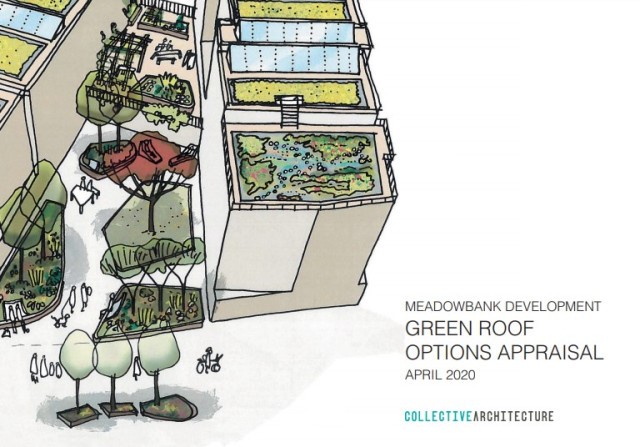Following a successful bid to the Green Recovery Challenge Fund, Greater Manchester have been awarded £1.8 million to spend on projects that boost habitat restoration, protect the environment and reconnect people with nature across the region. For more information, click here
Greater Manchester awarded £1.8 million to boost environment recovery
Creating a new urban park at Fernbrae Meadows
This weeks blog has been produced by greenspace scotland and NatreuScot, and looks at Fernbrae Meadows, a regeneration and GI project funded through NatureScots (SNH’s) Green Infrastructure Fund.
One of the jewels in the crown of this £38m investment programme supported by the European Regional Development Fund is the Fernbrae Meadows project in the Cathkin Braes area, South Lanarkshire. Here a former golf course, which had gone out of business and fallen derelict, has been transformed into a new urban park.
It’s the catalyst to regenerating an area which many will associate with the Glasgow 2014 Commonwealth Games and mountain biking events. Blessed with marvellous views north over Glasgow to the Campsies, this area nevertheless lacked good local greenspace … until now.
The closure of Blairbeth Golf Club in 2015 was bad news for golfers and ultimately for locals, as the site became a magnet for anti-social behaviour. Following community consultations, South Lanarkshire Council applied to the Fund and got the green light for their project.
Fernbrae Meadows
The 20-hectare site has been renamed Fernbrae Meadows at the suggestion of the local community. As it borders Cathkin to the east, Fernhill to the south, and Castlemilk to the west, it clearly has huge potential to be visited by many people and to connect hitherto distinct communities.
Local people are grasping the opportunity to use the park for a range of activities including health walks and school visits. Despite the project only being part complete, in spring and summer 2018 there were over two-dozen community events held in the Meadows.
Facilities and biodiversity
Now, a series of paths and cycle-ways greatly improve access and offer a network of green travel routes between the various communities bordering the site. Add to the mix seating, trails, community growing areas, visits for schools and volunteering opportunities and the site will clearly have a huge positive impact.
The biodiversity of the site will be enhanced by creating a series of natural meadows connected by woodland corridors, attracting back native species that had been driven away during the site’s intensive management as a golf course. The management and maintenance of the wetland area of the site will create an integrated natural habitat, reducing flood risk and creating more natural processes which will allow the watercourse to better support local ecosystems.
Next steps
It’s great to know that picking up the challenge of managing the site long-term is already in hand. A ‘Friends of the Park’ group will contribute much of the on-going park activity and maintenance.
In May the countryside rangers are organising wildflower planting and a drop in event for educators and families, exploring outdoor learning opportunities. In June the Friends group is planning a big summer event. Information about the events can be found on Facebook,Twitter and Instragram
Find out more about the background of the Fernbrae Meadows project
Meadowbank Green Roof Options Appraisal
Ivan Clark, Placemaking Team Manager at SNH, has provided June's blog. Here, he tells us about a partnership project exploring the contribution that green roofs can make to successful, climate-resilient places. He found that by applying the right kind of roof to the right building in the right place, green roofs can be a cost-effective way of helping cities adapt to the impacts of climate change, supporting the health and well-being of Scotland’s communities and providing habitats for wildlife…
Background
In a recent response to a Scottish Government request for advice on a ‘green recovery’ from Covid-19, the UK Climate Change Committee suggested, among other things, “supporting the green roof and sustainable drainage industries to help to bolster Scotland’s adaptation services sector.” This is to be welcomed, because although green roofs are commonplace in London and in much of Europe, there is very little use of Green Roof Infrastructure in Scotland, particularly in housing developments. A previous SNH Commissioned Report, Maximising the Benefits of Green Infrastructure in Social Housing, suggested that this was due to a lack of awareness of the benefits of green roofs, the need for a persuasive ‘business case’ and the assumption by some developers that the cost of green roofs could threaten development viability.
The Project
To address these perceptions, Scottish Natural Heritage has been working with City of Edinburgh Council and others to explore the viability of integrating green roofs into an existing development proposal. The Meadowbank Development Green Roof Options appraisal was the result of a partnership between the Scottish Government, Architecture and Design Scotland, the Scottish Federation of Housing Associations and City of Edinburgh Council.
The partners commissioned a highly-skilled and multi-disciplinary design team (comprising Architects, Landscape Architects, Structural Engineers, Quantity Surveyors and a leading UK Green Roof expert) to carry out a viability study based on an existing public interest led housing and mixed-use development proposal at Meadowbank, close to the centre of Edinburgh. The team took a collaborative place-based approach to exploring the solutions most appropriate to the specific challenges and opportunities at the site.
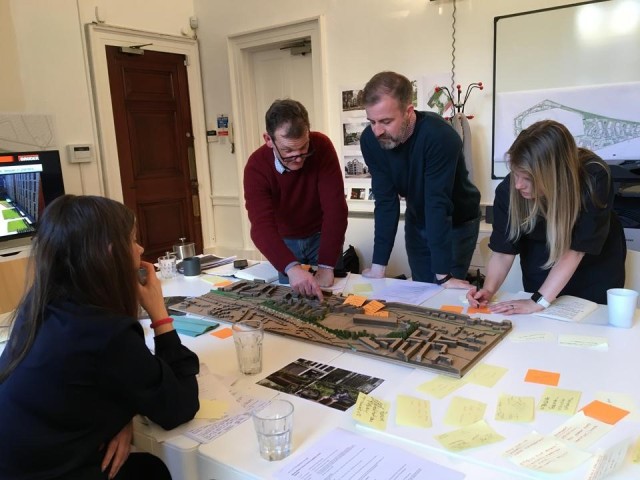
Having agreed the types of roof solutions that would provide the most benefits, the costs were calculated and the proposals refined. In terms of the ‘business case’, the report considered the role of the blue-green roofs in attenuating the flow of surface water and the implications of this for the use of land and the need for other grey infrastructure. It also looked at the likely energy savings from the green roofs over the long term.
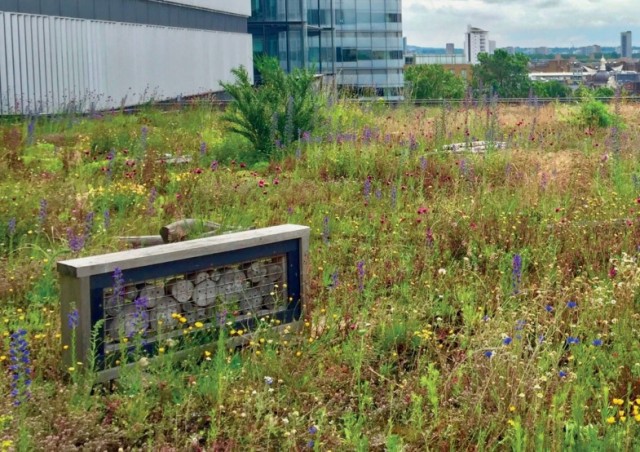
Key Findings
Green roofs at the Meadowbank site would help create an exemplar nature-rich development in the centre of Scotland’s capital city: Meadowbank is within a short flight of other pollinator habitat at Holyrood Park and the Scottish Parliament.
Green roofs would support the health and well-being of residents and provide benefits to the wider community that would use the site: Some of the green roofs could add value to potential community facilities such as nurseries and GP surgeries.
Green-blue roofs reduce the need for other grey infrastructure: Introducing green roofs across the site could result in a 38% reduction in the rate of surface water run-off. Along with other SUDs features, this could allow the removal of the need for below ground treatments (tanks and pipework) and reduce potential interference with contaminated land.
Green-blue roofs allow for more efficient use of land in constrained urban sites. Based on an average density of housing across the whole site of 110 dwellings/ ha, the space required for a ‘traditional’ SUDs pond, large enough to provide similar levels of attenuation provided by the blue-green roofs, would equate to around 40 dwellings per hectare.
Initial capital costs of green roofs are modest compared to overall capital costs of the development: The use of green roofs compared to traditional roofs represented an estimated uplift in overall construction costs for the whole development of less than 0.25%. If the additional capital costs of the roofs were split between all the dwellings at the site, the costs would equate to around £350 per dwelling. Based on their increased longevity and contribution to energy efficiency (insulating in winter and cooling in summer) the ‘payback’ period was estimated to be between 6 and 20 years.
The full report can be accessed here: https://www.nature.scot/meadowbank-development-green-roof-options-appraisal
Note: The options appraisal is based on a development proposal currently (as of May 2020) subject to a separate live planning application. The current application does not require roof types to be specified but in light of this report, City of Edinburgh Council will consider how green roofs could be incorporated at the next stage.
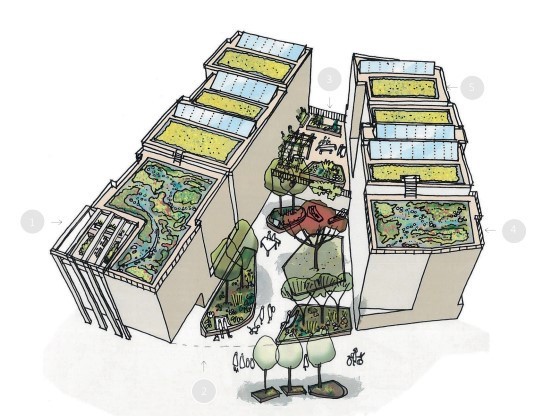
Raingardens for schools in North Lanarkshire
This months blog is written by Emilie Wadsworth from CSGNT and Neil McLean from Stantec, two of the partners working on the School Raingardens project in North Lanarkshire we showcased over a yer ago. The project has had to be paused due to the restrictions imposed by the Covid-19 pandemic, but is ready and raring to start up once again when able.
Over the last few years, Britain has seen some very heavy rainfall and intense storms, resulting in devastating floods. We all learnt about the water cycle at school, and how rain sinks into the ground, travelling slowly through the soil to rivers and eventually the sea. What we perhaps didn’t learn about is how this changes in our towns and cities where the ground is impermeable. The rain can’t sink into soil over the hard surfaces such as road, roof and footpaths, so it flows quickly into drains where it is moved, again very quickly, out into the rivers. This means that a lot of water is being pushed into the river system all at one go, making flooding worse. Dredging rivers isn’t the answer, as this just moves the problem instead of solving it. What we need to do, is slow the flow. Hold the water back, slowly releasing it, like a natural system would do. This is where Raingardens come in.
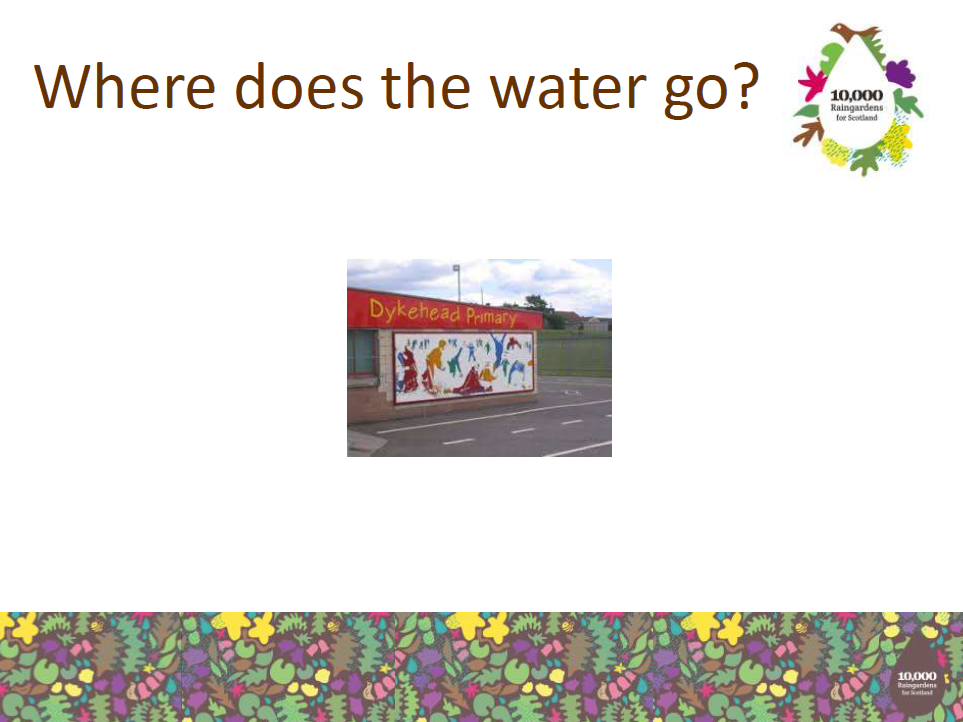
Raingardens are areas of plants specifically designed to receive rainfall and runoff and slow down water. They can help solve small areas of flooding, such as in a garden or car park. When lots of them are used, they can reduce the severity and impact of flooding on a larger area. They are also nice to look at, are good for biodiversity and can help reduce pollution.
North Lanarkshire Council have started an innovative project looking at primary schools in their area that either already suffer from flooding problems or are likely to in the near future. So far, five primary schools have had raingarden features designed around the playground, which will hopefully be installed before the end of the summer (coronavirus restrictions allowing). The project was run in partnership with CSGNT, Cumbernauld Living Landscapes and water engineers at Stantec. The partners ran education sessions with pupils in the school, teaching them about raingardens and then working with them to identify problem areas in the grounds and finally come up with ideas on what the raingardens should be. The schools will play an important role in looking after the raingardens and will be provided with information and resources to do that, and to use the raingardens for outdoor learning in the future.
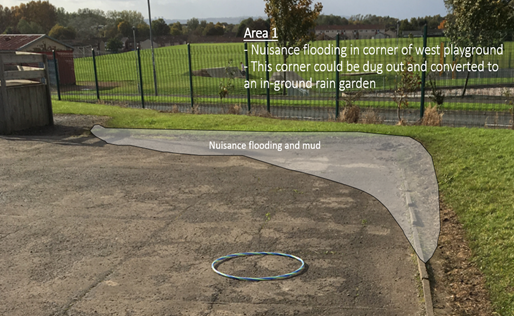
Kinross Raingardens Challenge
Mays blog comes from Brian D'Arcy, SGIF member on behalf of Kinross-shire Civic Trust, and bring us some exciting news on the Kinross Raingardens Challenge, part of the 10,000 Raingardens for Scotland campaign which Brian was a founding member of. The article is reproduced from the Kinross Community Council Newsletter:
Kinross Raingardens Challenge
Yes, after some months of hard work and dialogue, we can confirm Kinross-shire is to host a Raingardens Challenge! Led by the Kinross-shire Civic Trust, the aim is to have 20 raingardens in 2020.
We are following the simple meaning of the term ‘raingarden’ adopted by the Scottish Green Infrastructure Forum (http://www.sgif.org.uk):
A vegetated feature designed to accept rainfall runoff
In earlier issues of the Newsletter, we’ve written about the potential of using greenspace in our town and villages to create pleasing landscape features which can accept rainfall draining off roads, roofs and other impervious areas. The objective is to add flower beds - sometimes wildflower features, in other instances more like traditional garden planting with a wetland element - to our built environment to soften the harshness of a landscape often almost devoid of plants. The innovative aspect is the use of the landscape features to accept rainfall runoff, contributing to managing flood risks. If carefully designed, these raingardens help manage the greater rainfall intensity associated with climate change, as well as enhancing the appearance of the area.
To manage the potentially scouring impact of rainfall draining off a road for example, a complete cover by plants is desirable (see the roadside grass-and-wildflowers swale taking runoff from the link road in West Kinross for example). In smaller units, stones and gravel can be used to mitigate the impact of surges in runoff into the feature.
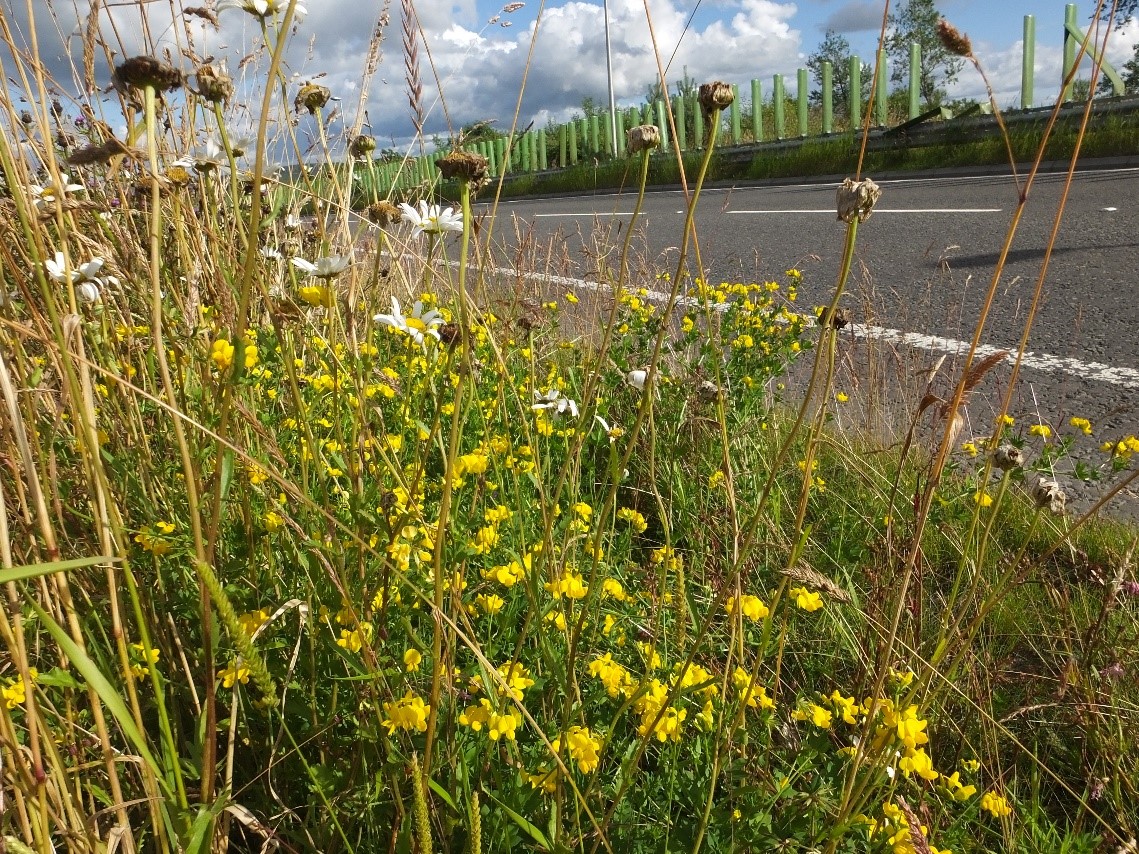
Swale in late summer, Kinross
We have some grass swales (e.g. West Kinross), but they can be improved in a few details. There are however other types of features we don’t yet have in Perth and Kinross, but which are widely used in some other parts of the world (e.g. USA, Australia – and now in Cardiff in Wales).
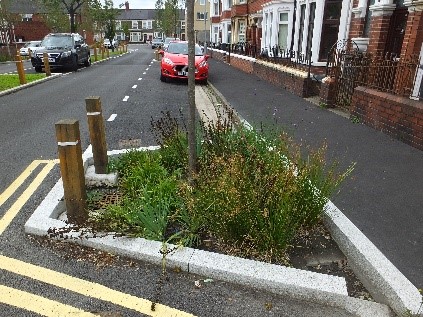
Cardiff raingarden – why not in Kinross too?
The Kinross-shire Raingardens Challenge is about encouraging Perth and Kinross Council, local businesses, and individuals to consider installing raingardens or making modifications to their drainage systems to create improved rainwater management by creating raingarden features. We hope to have awards for participating businesses and households and be able to celebrate success at events in 2021, including rewarding efforts to manage existing features and restore failed ones.
How you can get involved
- If you have a regularly flooded car park your premises, contact us before going for conventional reinstatement and see if there can be a raingarden solution
- If a road gully is regularly failing near you raise it with the Council (and Councillors); ask if they would consider a raingarden solution (no gully, remove a section of kerb and allow direct surface flow into the feature); Perth & Kinross Council contacts in the Newsletter.
- We hope to be able to offer advice and some help as the project gathers support.
- In the interim, please don’t fail to let SEPA and Scottish Water know if you see or are aware of problems with local flooding and sewage overflows from the drainage system or treatment works in Kinross, Milnathort and Kinnesswood. SEPA pollution hotline is 0800 80 70 60 and Floodline is 0345 988 1188; see https://www.sepa.org.uk/contact/. For Scottish Water: https://www.scottishwater.co.uk/en/Your-Home/Sewage-Pollution/Sewage-Pollution-Form or https://www.scottishwater.co.uk/en/In-Your-Area/Flooding-Information/Report-a-Flooding To report a flooding incident which appears to be contaminated with sewage: Call the Customer Helpline on 0800 0778 778
Finally for this article, we wish to thank Hannah and the Kinross Newsletter team, SEPA, Scottish Water, Perth and Kinross Council, and Tayside Biodiversity Partnership, for their support.

Chair and Secretary of Kinross-shire Civic Trust after meeting with Scottish Water



